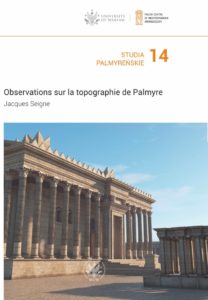-
BUY ONLINE
-
, Observations sur la topographie de Palmyre (=Studia Palmyreńskie 14), Warsaw: PCMA UW, WUW, 2021
Warsaw 2021
1st edition
ISBN 978-83-235-5488-2
https://doi.org/
298 Pages
Soft cover with flapsThe studies collected in this volume are the fruit of many years of investigations carried out by the author in Palmyra, on the magnificent ancient Hellenistic and Roman remains of this oasis city in the Syrian desert, exceedingly mutilated during the recent conflict in Syria. In his research, Jacques Seigne draws upon a rich literature, including the most recent published studies, and his own experience of “walking, measuring and drawing” Palmyra between 1977 and 1996, as well as a lifetime of research into Palmyrene matters.
Seigne examines first the chronology, development, reconstruction and function of single architectural structures and buildings following a topographical order, and then goes on to consider thematic issues linked to a study of the circulation network within the city and in its immediate surroundings. The first part of the book, encompassing 10 chapters, presents individual monuments and areas, such as the buildings on Gebel Mountar, the agora and its annexes, the two monumental “columns of Baalshamin”, a monumental altar under the Great Colonnade, and the so-called Caesareum, the theatre, the monumental Arc, the west facade of the early sanctuary of Bel, the sanctuary of Nabu and its so-called banquet hall. The six chapters in the second part of the volume are devoted to considerations of the circulation network within the city and in its immediate surroundings: the Great Wadi Al-Suraysir, the road running in it, and the access situation from there to the agora, the Transversal Colonnade and the three sections, A, B and C, of the Great Colonnade. This is followed by a chapter, in which the author sums up his views on the urban development of the city from the second millennium BC through the 4th century AD. The water supply and distribution system within the city is also treated in a separate chapter.
Bringing together these observations and hypotheses concerning the topography of the ancient city, Seigne gives a long-awaited, provisional synthesis of the urban development of Palmyra from the 2nd millennium BC to the beginning of the 4th century AD.
Jacques Seigne is a French archaeologist and architect whose professional career has taken him to archaeological excavations, first on Delos in Greece, then in Syria and Jordan. He is a qualified architect with a PhD in History. He worked from 1977 until 1996 in the Institut français d’archéologie du Proche-Orient (Ifapo), mostly in Palmyra documenting the sanctuary of Nabu, and in Jerash (Jordan). Back in France, he was Director of Research at the CNRS and lectured at the François Rabelais University in Tours.
He was called upon repeatedly as an expert on the restoration of historical monuments in Syria and Jordan. He is currently a member of the UNESCO Scientific Committee for restoration and management of the monuments of Palmyra.
For download:
